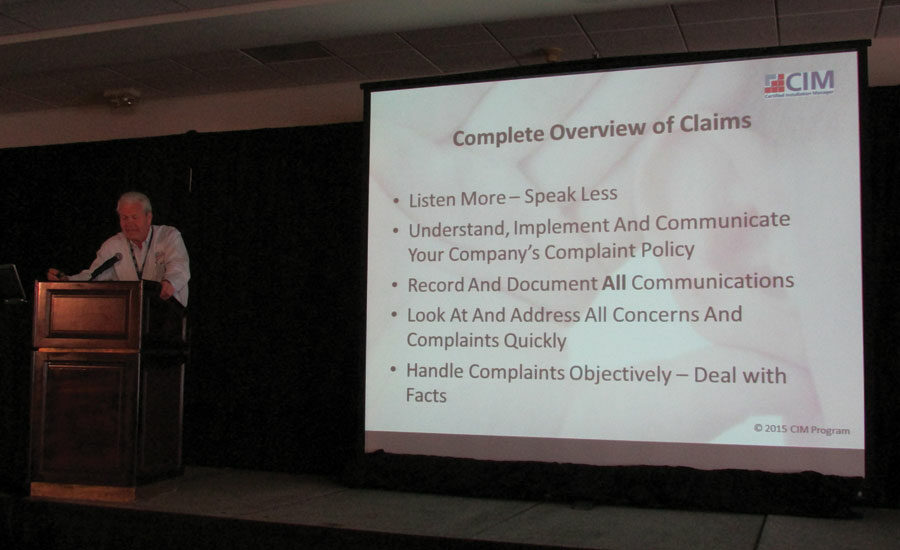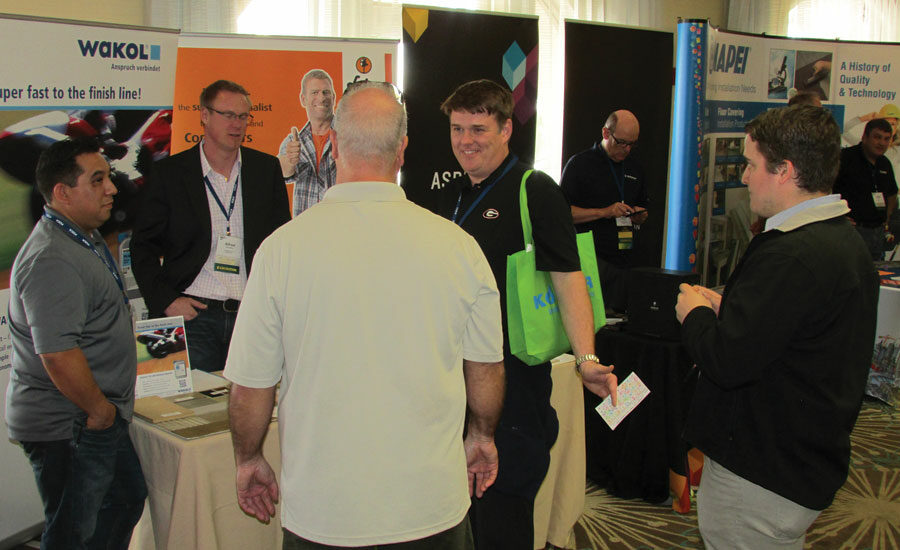FCICA Event Sees Record Attendance As Commercial Business Booms












At the opening of the show, Swift announced he would be stepping down as chairman on July 1, as he has completed his two, two-year terms. Mike Newberry, vice president of labor relations for Inside Edge Commercial Interior Services, is set to succeed Swift. “We spoke to Mike a year ago about this, and he is very supportive of what we’re doing and wants to continue on that path,” Swift noted.
Jim Walker, CEO of the International Certified Floorcovering Installers Association (CFI), was at the opening general session and was recognized as an honorary member of FCICA. According to Swift, “We wanted to honor Jim because honorary memberships recognize people who have done a lot for the industry as a whole, and Jim has certainly done that.”
The show also marked the conclusion of the filming of live video modules for the group’s Certified Installation Manager (CIM) program, which Swift said is still in a “pre-launch phase. Currently there are four modules and four assessment tests available on the online CIM portal. The final four modules have been captured and assessment tests will follow shortly.”
He added the program is “open to everyone in the industry, but you can enjoy tremendous savings if you are an FCICA member. We captured our first video in 2013, and what we need to do now is finish up the remaining tests and get our first CIM people out in the industry. Our Installation Task Force and the rest of our staff are working very hard on this. Right now we have about 40 members waiting to be certified.”
Educational Sessions
FCICA offered a range of educational sessions designed to arm attendees with the latest best practices for running a floor covering installation business from the management side.
Terry Wheat, president and owner of flooring business software provider RFMS, presented “Financial Management: Budget vs. Actual,” where he stressed the importance of getting installers into the habit of keeping documentation. “Everyone can take pictures and movies with their cell phones. There is no excuse not to have a system of documentation in place.”
He cautioned managers to always reconcile any change orders with the actual budget. “Create a master list of activities and costs, and manage it each day. Recalculate based on changes. Anyone can reactively manage a situation, but that’s where you see profit erosion. Updating a project’s status proactively must be a relentless job for installation managers.”
Wheat added, “Financial management is built on what can be verified and measured. If you can’t track it, you can’t measure it. If you can’t measure it, you’re losing money.”
John Kozak, CBC Flooring’s technical services manager; Sonny Callaham, Royal Adhesives & Sealants’ technical product manager, and Sim Crissler, vice president of LGM and Associates, shared their perspectives on “Handling Claims on the Jobsite.”
Kozak mentioned to check freight for both apparent and potential hidden damages, and document all findings.
Callaham stated, “Communication is the most important key to resolving claims issues. Make sure to have documentation, including the exact name of the adhesive and the exact name of the flooring. You may think this is commonsense, but it’s a challenge sometimes for manufacturers to get even this basic information.”
He added to keep pictures of the jobsite before, during and after the installation. “Also keep job diaries, letters, emails, minutes from meetings—anything related to the project. You never know what will help you.”
Crissler reiterated this point, and also said to stop worrying whether a claim is going to come and simply prepare for it. “Claims are pretty much inevitable. Everything from a fall in a parking lot to a problem with the substrate is a potential claim.”
According to Amy Johnston, Flooring Services’ project estimator and coordinator—who shared the stage with J.R. Allred, COO and operations manager of Dalton Carpet One, to present “Closing Out the Job”—make sure to understand everything you promised in the contract.
“Some questions to ask are what are the reclamation costs on the job, dumpster or trailer? Who is responsible for final protection and cleaning, and what does it entail? If you are contracted for full coverage, make sure to take pictures before and after the protection application.”
She added the end of the job is an ideal time to prospect for another job. “Bring up any maintenance programs or other areas you noticed that may need replacement.”
Allred said one great way to differentiate your business is to provide a binder full of warranty, care and maintenance documents for the products used. “You can easily download warranty and maintenance documents from manufacturers’ websites. However, make this easy to read. Don’t just shove a bunch of manufacturers’ warranties into a binder. Professionalism is an important part of differentiation in the marketplace.”
Jack West, Federated Insurance’s national account executive, spoke about the importance of risk management in “Risk Management Culture—A Vision for Your Future.”
He also used the presentation to talk about the newly updated FCICA Start with Safety training program. “The program is designed to be used for 52 weeks. There are 52 tabbed topics for weekly trainings. New content topics include material handling and storage, as well as trips and falls.”
Tabletop Trade Show
FCICA hosted a trade show with close to 40 exhibitors, including Advanced Adhesive Technologies, Ardex, Bona, CMP Specialty Products, Ecore Commercial Flooring, Flexco, H.B. Fuller Construction Products, Halex, Johnsonite, Koster American, Loba-Wakol, MAPEI, Metroflor, Moldings Online, Protect-All Flooring, RFMS, Roppe, Royal Adhesives & Sealants, Schönox/HPS North America, Tramex, Traxx, USG, Uzin, W.F. Taylor and Wagner Meters.
Bill Luallen, national sales director for flooring maintenance products company XL North, said he appreciated this event because “we sell to the end-user and the contractor, so it’s extremely important to get out here in front of these kinds of people. The general contractor will often scratch out initial maintenance as not being in the scope. That’s money lost.”
Kevin Hawthorne, director of surface preparation for equipment distributor Aramsco, echoed those sentiments. He also hosted an educational session on mechanical surface prep, including floor scrapers, surface blasters, scarifiers, grinders, polishers and the importance of dust collection.
“When you are selecting between these machines, make sure you match the process with the end result. If the existing concrete has flaws, polishing will only magnify these flaws. Whatever method of mechanical prep you use, dust control is critical. It is not optional.”
One first-time attendee—Larry Chandler, William M. Bird’s director of commercial sales—said he felt invigorated by the show. “I wanted to be involved in the past, but I was on the board of FIANA and couldn’t do both. Once FIANA dissolved, I decided to see what this group is all about. My first impression is you can transfer a lot of these skills to how distributors run their businesses as well. My mind is racing with ideas.”
Swift noted installation managers are often former installers themselves. “This job is certainly not restricted to former installers, but it does create a career path for installers. They can get off their knees after [so many] years, and know there is something else in the company for them to earn more money.”
He said the economy continues to improve by leaps and bounds. “We’re all busy now. Our emails are filling up with job prospects and invitations. That’s the good news. The bad news is a lot of people haven’t prepared for it. You hear it all the time: Where are all the good installers? Where are all the good people? Well, the people that were laid off six or seven years ago have probably moved on at this point. That’s always going to be the challenge.”
Looking for a reprint of this article?
From high-res PDFs to custom plaques, order your copy today!













